Hawaii a destination for adventure, yet officials continue to push for precaution in a daunting fight
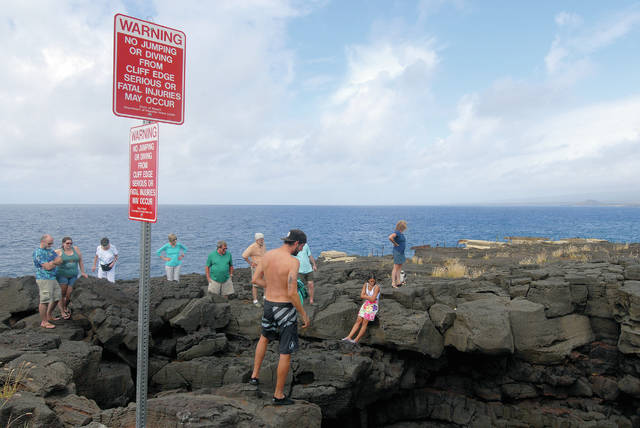
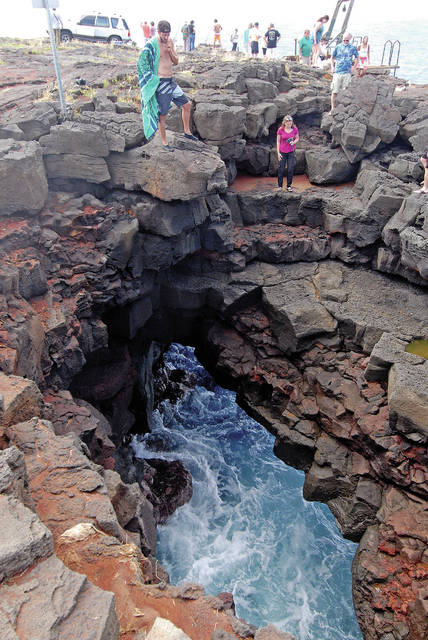
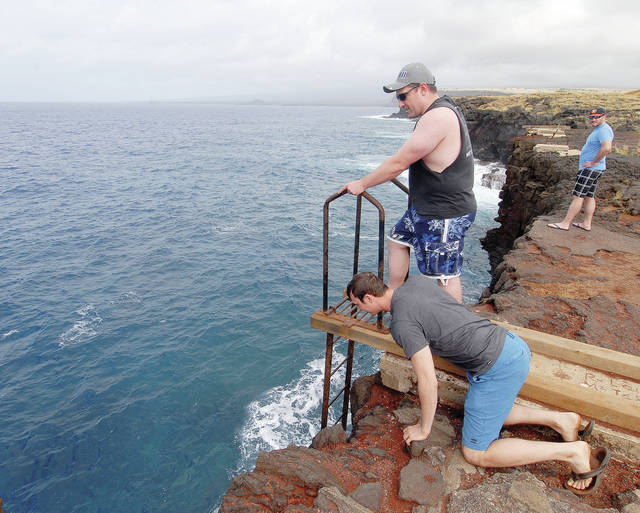
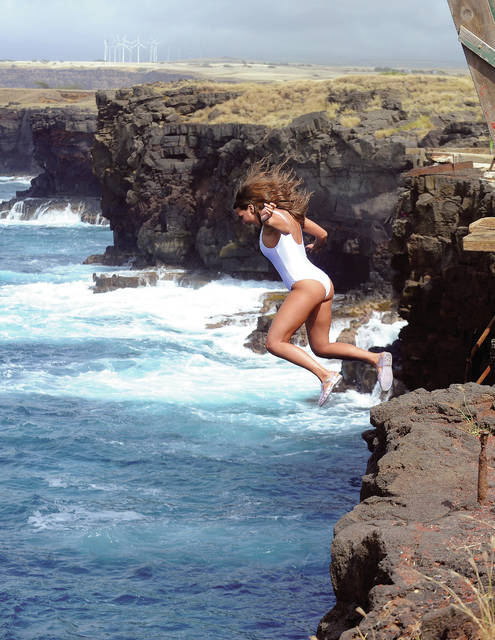
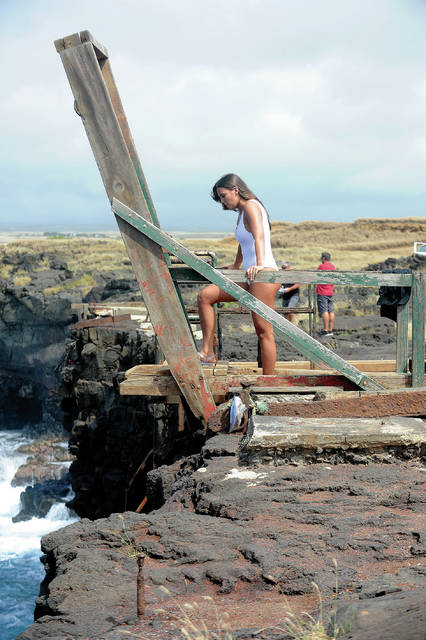
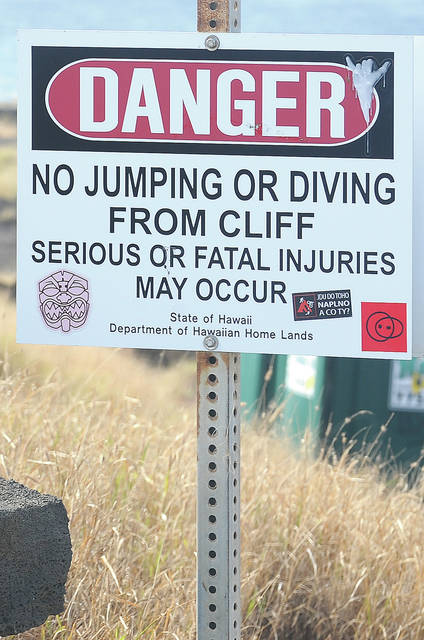
KA LAE — For a moment, Marek Zak was flying.
KA LAE — For a moment, Marek Zak was flying.
Leaping from atop a boat hoist, Zak took off before gravity caught him, sending the 30-year-old down from view, nothing to catch him but the ocean.
ADVERTISING
There was a splash, and moments later, Zak climbed the ladder 40 feet back onto the cliff, where his father and sister waited.
Zak, from the Czech Republic, had visited Ka Lae, or South Point, twice before in the two months he’s been staying in Hawaii. Now with family visiting, it was his last chance to visit before they all head off on a tour of the islands and then he makes his way to New Zealand.
“To feel free, you know, like a bird,” he said about why he liked the jump. His favorite jump is into a hole a few yards from the hoist. That one drops into the churning waters below, and connects back out to the ocean.
His sister, Karolina Zakova, also made the leap from the cliff on Thursday.
A fan of roller coasters and zip lines, Zakova said she wanted to check it out — the heart-and-blood-pumping adventure Hawaii Island’s southern tip is famous for — after hearing about it from her brother.
“Definitely way too much adrenaline,” she said after her jump, “because you’re actually just free falling, it’s not like you’re strapped into something.”
Caution to the wind
Every day, visitors make their way down South Point Road to the cliffs, which are often lined with the poles of ulua fishermen. Most who take the leap jump from a boat hoist 40 feet into the sea below before making their way back up a ladder that extends from the water back to the cliffs. Rescue officials and the Hawaii Tourism Authority, as well as some guides for that matter, warn of the dangerous currents in the area and advise against swimming there.
Nonetheless, many take the plunge every day.
The jump is a popular activity, despite not being sanctioned by officials. “South Point Cliff Dive” has a 4.7-star rating on Google from nearly 480 people and a YouTube search turned up more than 13,000 videos, the most popular of which has been viewed more than 3.5 million times. Online guides and print guidebooks also reference the location and jump, often with disclaimers.
But jumping is highly discouraged.
The land itself is owned by the State of Hawaii, and signs from the Department of Hawaiian Home Lands explicitly say “no jumping or diving from cliff edge,” noting the risk of serious or fatal injuries.
And if government warning signs aren’t enough to communicate the risk, a cross stands just yards from the hoist, memorializing a Peruvian man, who died Feb. 5 after jumping into the water to assist a friend who had been swept under a current after jumping in.
The destination’s reluctant popularity is a growing challenge as more and more visitors seek out sights and thrills off the beaten path. But in addition to visitors risking their own safety and well-being, officials also worry about the impact to the state’s resources and community, particularly in places with fragile environments or that aren’t designed or intended for heavy use and foot traffic.
It’s also one without an easy answer, though officials are dedicated to addressing it.
Potential solutions range from increased enforcement to simply acknowledging that there’s just no keeping people out of some places. The state’s Department of Land and Natural Resources and Hawaii Tourism Authority are meanwhile exploring ways to push back against the promotion of trespassing and rule-breaking on social media.
But the signs and warnings do little discourage the thrill-seekers who come nearly every day to Ka Lae and elsewhere, spurred on by word of mouth, online guides or social media.
“People like to go places that they see on these sites, but not really understanding what the hazards are,” said Gerald Kosaki, battalion chief of special operations for the Hawaii Fire Department.
Ka Lae isn’t the only place drawing visitors for its secluded allure.
Kosaki said other sites like Waimanu, Pololu and Waipio Valley and the lava flow all draw visitors to places not only out of the way of other tourists, but also away from a quick emergency response.
The thrill overriding the caution
Zak readily said jumping at Ka Lae wasn’t for everyone. He said everyone should pause and take into account their own abilities.
Getting down is the easy part. Once you’re in the ocean, the only way back up is the 40-foot vertical ladder climb.
“You have to be confident that you will make it up there,” Zak said, “not only down.”
On Thursday, the ladder and the current led some to decide the thrill wasn’t worth it.
A group of visitors who arrived at Ka Lae earlier in the day spent some time checking out the area before ultimately deciding against jumping, citing the current and iffy conditions of the ladder they’d need to use to get back out.
The allure of these off-the-beaten-path destinations represent a larger problem officials are trying to get a handle on: picturesque photos and posts on social media and online guides directing visitors to sites not designed or managed for major crowds.
It’s also nothing new.
48 trespassing citations in July
Last July, officers with the Department of Land and Natural Resources’ enforcement arm wrote 48 citations in one day for trespassing into the Kohala Forest Reserve on a route known as White Road Trail, a trail that is effectively off-limits to hikers. A DLNR spokeswoman said all violators received a $100 fine. Local residents had the fine converted to 11 hours of community service work.
Access to the White Road Trail requires permission to cross DHHL property, which that agency has said it won’t grant.
But like the signs at Ka Lae, the “kapu” signs and threat of citations there can’t deter those determined to seek out a thrill away from the recommended path.
Curt Cottrell, administrator of the Division of State Parks under DLNR, said they’re also seeing the trend and trying to see what can be done about it.
“Social media is helping us love our resources to death at a faster rate than we’ve ever been able to love them to death before,” he said.
Cottrell said there has been a lot of success when it comes to guidebooks, saying some have actually pulled back on promoting out-of-bound sites. But the impact of that success, he added, “has been vastly outweighed” by the impact of the general public posting online about their day trips.
More trespassing, more dangers
Oahu destinations like Sacred Falls Park are also drawing visitors even though it’s officially closed to the public.
After a rock slide at Sacred Falls killed eight in 1999, officials closed the park.
The park is still off-limits, given the potential for another rock slide, but photos and videos continue to appear online, including a recent Instagram post of a person lifting a middle finger to a warning sign at the gate.
In response to the continued visits there, DLNR created a video about the rock slide, featuring footage of people getting cited and an interview with a cultural practitioner.
Parks staff posted smartphone-scannable QR codes on posts beyond the park’s entryway, giving trespassers a warning about what they risked by going forward.
Within the first few days, DLNR saw that the video had already been viewed 58 times.
While they can’t know how many people ultimately proceeded with the hike, Cottrell said, it was a way of knowing how many people were at least going beyond the initial “danger” signs.
It’s also not just a question of safety, but also of the risk to the resources themselves.
While some activities can have an immediate, visceral impact on a resource, he said, for most it’s a subtle decrease in the quality of the resource.
At Kiholo State Park Reserve, eight miles north of Kekaha Kai State Park, there’s a popular water-filled cave where staff have found evidence of visitors and residents burning candles — which has since introduced cockroaches into the cave — as well as smoking cigarettes and drinking in the cave.
Other impacts seen include human waste, he said, as well as the impact hordes of rental cars have by filling up small neighborhood streets.
“If people even just behaved with more reverence and respect, … if people just pitched a tent and bagged up all of their human waste and left the place exactly as they found it, then government wouldn’t need to be so draconian and come in and shut it down for everybody,” Cottrell said.
The ‘big question’
So what’s to be done, especially for sites like Ka Lae and the Kohala Forest Reserve, which aren’t under the parks division’s purview?
“That’s the really big question,” Cottrell said.
Building a fence won’t work, he said, nor will a wall of signs.
On the one hand, it could be a matter of manpower within the Parks Division, by putting staff at certain locations that can both interpret the resource but also offer some enforcement power. While that would work at the Parks Division, he said, he can’t imagine the Department of Hawaiian Home Lands — the state agency responsible for administering homestead leases — doing that at places like Ka Lae, given that’s not the agency’s mandate.
Internally, he said, DLNR and the Hawaii Tourism Authority are looking for a better method of searching social media, potentially with a person who can track posts as well as develop a strategy for getting the word out about unmanaged sites where visitors can harm the environment or themselves.
Some places, he said, officials might just need to write off and acknowledge that the resources are going to degrade and people might be in jeopardy, but as long as the state or taxpayers aren’t at risk of litigation, it’ll just be situation where people are responsible for themselves.
And then there’s the bigger question.
How much more money should the state invest in marketing a state that welcomed 9.38 million people in 2017, and anticipates to attract more than 10 million in 2021? Those figures are what the Hawaii Department of Business, Economic Development and Tourism anticipate.
The question then, Cottrell said, is whether the state still needs to advertise or if it’s better to reinvest that money into “the goose that lays the golden egg,” by making the state’s resources and community better and safer.
In the meantime, officials are finding wins and solutions where they can. After years of people at Kiholo driving onto the ‘ili‘ili stone beaches and parking bumper-to-bumper for camping, wearing the pebbles to powder, the Parks Division responded by installing bollards and regulating the camping.
“We took the quantity of the experience and we brought it down to a scale where the quality of the experience is now more appropriate for the cultural significance of Kiholo,” Cottrell said.
They’ve also “become very swift” in responding to online listings for tours of unauthorized areas in parks as well as advertisements for parties where such activity is prohibited.
‘Stay wild — and stay alive’
But until some overarching solution comes to be — assuming one exists — places like Ka Lae will continue to draw visitors.
Back on the cliffs, Marek Zak stood at the edge of the blowhole considering his last chance to drop in.
With the Pacific churning beneath his feet, and watching as the water washed back and forth over the rocks, he stepped back from the brink.
“It’s important to know when to say no,” he said. “My motto is ‘stay wild — and stay alive as well.’”
Email Cameron Miculka at cmiculka@westhawaiitoday.com



Stupid is as stupid does….some will go home in bodybags.
I’ve been to most these places, on the big island.
My main advice is,
if locals aren’t there playing, stay way.
The exception to that rule is Snow on Mauna Kea
or Mauna Loa. Locals don’t have a clue
about Snow, black ice, or really cold things.
Yes it is definitely time to the HTA’s tax subsidised advertising budget.